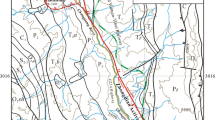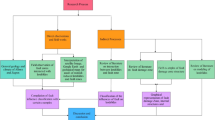Abstract
The platforms of old landslides triggered by historical earthquakes have often been important residential and agricultural places in active tectonic regions. In recent years, many old landslides have been reactivated due to various causes. Previous studies have shown that the hydrodynamic effect is an important triggering factor for landslide reactivation. However, as an old landslide has undergone a long consolidation period, the permeability of deposits is generally very low, and surface water can hardly infiltrate into deep zones of landslide deposits. Through field investigation, it is found that many old landslides are reactivated due to the coupled action of water infiltration and cracks in the east Tibetan Plateau. The cracks are controlled by fault creep in the initial formation process. In this paper, taking the Chashushan old landslide in the upstream of Jinsha River as a case study, field investigation, experimental study, numerical simulation, and PS-InSAR technique are performed to investigate the reactivation mechanism of the old landslide. The influences of cracks, rainfall, and canal leakage on old landslide reactivation are discussed. The cracks controlled by fault creep provide channels or media for the rapid infiltration of surface water, which is the triggering factor of landslide reactivation. The results in this paper can provide an important reference for research on the reactivation mechanism and risk control of old landslides in the east Tibetan Plateau and even in active tectonic areas around the world.














Similar content being viewed by others
References
Bai YJ, Zheng WM, Li MH, Yi ZJ, Wang DH (2010) Characteristics and formation mechanism of Chashushan landslide on Sichuan-Tibet highway. J Eng Geol 18(6):862–866 (in Chinese with English abstract)
Bao YD, Zhai SJ, Chen JP, Xu PH, Zhou XH, Zhan JW, Zhang W, Zhou X (2019) The evolution of the Samaoding paleo landslide river blocking event at the upper reaches of the Jinsha river, Tibetan. Plateau Geomorphol 351:106970
Brooks R, Corey A (1964) Hydraulic Properties of Porous Media. Colorado State University, Colorado
Chen J, Zhou W, Cui Z, Li W, Wu S, Ma J (2018) Formation process of a large paleolandslide-dammed lake at Xuelongnang in the upper Jinsha river, SE Tibetan Plateau: constraints from OSL and 14C dating. Landslides 15:2399–2412
Chen HR, Qin SQ, Xue L, Xu C (2021a) Why the Xintan landslide was not triggered by the heaviest historical rainfall: Mechanism and review. Eng Geol 294:106379
Chen J, Cui ZJ, Chen RC, Zheng XX (2021b) The origin and evolution of the Temipaleol and slide-dammed lake in the upper Jinsha River. Earth Sci Front 28(2):85–93 (in Chinese with English abstract)
Comsol (2013) COMSOL Multiphysics 4.3b, User 's Guide
Crosetto M, Monserrat O, Iglesias R, Crippa B (2010) Persistent scatterer interferometry: potential, limits and initial C- and X-band comparison. Photogramm Eng Remote Sens 76(9):1061–1069
Editing Group of Compilation of Seismic Data in Sichuan Province (1980) Compilation of seismic data in Sichuan Province 1: 217–221 Sichuan People’s Publishing House (in Chinese)
Fan XM, Xu Q, Alonso-Rodriguez A, Subramanian SS, Li WL, Zheng G, Dong XJ, Huang RQ (2019) Successive landsliding and damming of the Jinsha River in eastern Tibet, China: prime investigation, early warning, and emergency response. Landslides 16(5):1003–1020
Ferretti A, Prati C, Rocca F (2000) Non-linear subsidence rate estimation using permanent scatterers in differential SAR interferometry. IEEE Trans Geosci Remote Sens 38(5):2202–2212
Floris M, Bozzano F (2008) Evaluation of landslide reactivation: a modified rainfall threshold model based on historical records of rainfall and landslides. Geomorphology 94:40–57
Fruneau B, Achace J, Delacourt C (1996) Observation and modeling of the Saint-Etienne-de-Tinee landslide using SAR interferometry. Tectonophysics 265:181–190
García-Delgado H (2020) The San Eduardo Landslide (Eastern Cordillera of Colombia): reactivation of a deep-seated gravitational slope deformation. Landslides 17:1951–1964
Guo CB, Zhang YS, Li X, Ren SS, Yang ZH, Wu RA, Jin JJ (2020) Reactivation of giant Jiangdingya ancient landslide in Zhouqu County, Gansu Province, China. Landslides 17:179–190
Guo J, Cui Y, Xu W, Yin Y, Li Y, Jin W (2022) Numerical investigation of the landslide-debris flow transformation process considering topographic and entrainment effects: a case study. Landslides 19:773–788
Hanssen RF (2005) Satellite radar interferometry for deformation monitoring: a priori assessment of feasibility and accuracy. Int J Appl Earth Obs Geoinf 6:253–260
He K, Ma G, Hu X, Liu B (2021) Failure mechanism and stability analysis of a reactivated landslide occurrence in Yanyuan City, China. Landslides 18:1097–1114
Hilley GE, Bürgmann R, Ferretti A, Novali F, Rocca F (2004) Dynamics of slow-moving landslides from permanent scatterer analysis. Science 304:1952–1955
Huang D, Gu DM, Song YX, Cen DF, Zeng B (2018) Towards a complete understanding of the triggering mechanism of a large reactivated landslide in the Three Gorges Reservoir. Eng Geol 238:36–51
Iverson RM, George DL, Allstadt K, Reid ME, Collins BD, Vallance JW, Schilling SP, Godt JW, Cannon CM, Magirl CS, Baum RL, Coe JA, Schulz WH, Bower JB (2015) Landslide mobility and hazards: implications of the 2014 Oso disaster. Earth Planet Sci Lett 412:197–208
Kim JW, Lu Z, Kimberly D (2016) Ongoing deformation of Sinkholes in Wink, Texas, observed by time-series Sentinel-1A SAR interferometry (Preliminary Results). Remote Sens 8:313
Lacroix P, Handwerger AL, Bièvre G (2020) Life and death of slow-moving landslides. Nat Rev Earth Environ 1:404–419
Lee SJ, Hashash YMA, Nezami EG (2012) Simulation of triaxial compression tests with polyhedral discrete elements. Comput Geotech 43:92–100
Li TL, Xi Y, Hou XK (2018) Mechanism of surface water infiltration induced deep loess landslide. J Eng Geol 26(5):1113–1120 (in Chinese with English abstract)
Li YC, Chen JP, Zhou FJ, Song SY, Zhang YW, Gu FF, Cao C (2020) Identification of ancient river-blocking events and analysis of the mechanisms for the formation of landslide dams in the Suwalong section of the upper Jinsha River. SE Tibetan Plateau Geomorphol 368:107351
Ma S, Qiu H, Hu S, Yang D, Liu Z et al (2021) Characteristics and geomorphology change detection analysis of the Jiangdingya landslide on July 12, 2018, China. Landslides 18:383–396
Ni H (2009) Detailed investigation report on geological hazards in Batang County Geological Survey Report of Chengdu Geological Survey Center (in Chinese)
Ren Y, Li T, Dong S, Tang J, Xue D (2020) Rainfall-induced reactivation mechanism of a landslide with multiple-soft layers. Landslides 17:1269–1281
Rosone M, Ziccarelli M, Ferrari A, Farulla CA (2018) On the reactivation of a large landslide induced by rainfall in highly fissured clays. Eng Geol 235:20–38
Scheingross JS, Minchew BM, Mackey BH (2013) Fault-zone controls on the spatial distribution of slow-moving landslides. Geol Soc Am Bull 125(3):473–489
Shao W, Yang Z, Ni J, Su Y, Nie W, Ma X (2018) Comparison of single- and dual-permeability models in simulating the unsaturated hydro-mechanical behavior in a rainfall-triggered landslide. Landslides 15:2449–2464
Shen W, Tl Li, Berti M, Li P, Lei YL, Shen YQ (2021) Numerical modeling of bed deposition in rapid flow-like landslides: a case study of the Gaolou landslide in Shaanxi Province, China. J Mt Sci 18:599–613
Tu GX, Huang D, Deng H (2019) Reactivation of a huge ancient landslide by surface water infiltration. J Mt Sci 16(4):806–820
Wang X (1990) Intensity and isoseismal characteristics of the earthquake in 1870 in Batang County, Sichuan Province. Sichuan Earthq 4:89–94 (in Chinese with English abstract)
Wang Y, Li X, Zheng BW, Zhang YX, Li GF, Wu YF (2016) Experimental study on the non-Darcy flow characteristics of soil–rock mixture. Environ Earth Sci 75(9):1–18
Wasowski J, Bovenga F (2014) Investigating landslides and unstable slopes with satellite Multi Temporal Interferometry: Current issues and future perspectives. Eng Geol 174(8):103–138
Xie M, Zhao W, Ju N, He C, Huang H, Cui Q (2020) Landslide evolution assessment based on InSAR and real-time monitoring of a large reactivated landslide, Wenchuan. China Eng Geol 277:105781
Xu XW, Zhang PZ, Wen XZ, Qin ZL, Chen GH, Zhu AL (2005) Features of active tectonics and recurrence behaviors of strong earthquakes in the western Sichuan Province and its adjacent regions. Seismol Geol 27(3):446–461 (in Chinese with English abstract)
Yin YP, Li TQ, Tang J (2008) Landslide reactivation and emergency stabilization on Danba County town in Sichuan Province. Chin J Rock Mech Eng 27(5):971–978 (in Chinese with English abstract)
Zhang ZL (2020) Mechanism of the 2019 Yahuokou landslide reactivation in Gansu, China and its causes. Landslides 17:1429–1440
Zhang YS, Zhao XT, Lan HX, Xiong TY (2011) A Pleistocene landslide-dammed lake, Jinsha River, Yunnan, China. Quatern Int 233:72–80
Zhang YS, Guo CB, Lan HX, Zhou NJ, Yao X (2015) Reactivation mechanism of ancient giant landslides in the tectonically active zone: a case study in Southwest China. Environ Earth Sci 74(2):1719–1729
Zhang Y, Meng X, Chen G, Qiao L, Zeng R, Chang J (2016) Detection of geohazards in the Bailong river basin using synthetic aperture radar interferometry. Landslides 13:1273–1284
Zhang YS, Wu RA, Ren SS (2021) Influence of rainfall preponderance infiltration path on reactivation of ancient landslide. J Rock Mech Eng 40(4):777–789 (in Chinese with English abstract)
Zhao KY, Xu Q, Liu FZ, Zhang XL (2020) Seepage characteristics of preferential flow in loess. Chin J Geotech Eng 42(5):941–950 (in Chinese with English abstract)
Zhou C, Shao W, Van Westen CJ (2014) Comparing two methods to estimate lateral force acting on stabilizing piles for a landslide in the Three Gorges Reservoir, China. Eng Geol 173:41–53
Zhou X (2019) The Mechanism Analysis and Susceptibility Mapping of the Landslides along the Maoding River at the Upstream of the Jinsha. Jilin University, PhD thesis: 1–155
Acknowledgements
We are grateful to Prof. Ge Daqing and Prof. Guo Zhaocheng for their help in processing the PS-InSAR data. The Sentinel-1 datasets were provided by Copernicus and ESA, and the precipitation data were provided by the National Meteorological Science Data Center of China free of charge.
Funding
This research was funded by the National Natural Science Foundation of China (Nos. 41731287, 41941017).
Author information
Authors and Affiliations
Contributions
Y. Zhang and S. Ren developed the research plan and prepared the manuscript. X. Liu processed the PS-InSAR data. C. Guo, J. Li, and J. Bi carried out the field investigation, and L. Ran helped to process some figures.
Corresponding author
Ethics declarations
Conflict of interest
The authors declare no competing interests.
Rights and permissions
Springer Nature or its licensor (e.g. a society or other partner) holds exclusive rights to this article under a publishing agreement with the author(s) or other rightsholder(s); author self-archiving of the accepted manuscript version of this article is solely governed by the terms of such publishing agreement and applicable law.
About this article
Cite this article
Zhang, Y., Ren, S., Liu, X. et al. Reactivation mechanism of old landslide triggered by coupling of fault creep and water infiltration: a case study from the east Tibetan Plateau. Bull Eng Geol Environ 82, 291 (2023). https://doi.org/10.1007/s10064-023-03290-5
Received:
Accepted:
Published:
DOI: https://doi.org/10.1007/s10064-023-03290-5




